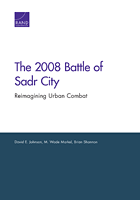| 来源类型 | Research Reports
|
| 规范类型 | 报告
|
| ISBN | 9780833080288
|
| 来源ID | RR-160-A
|
| The 2008 Battle of Sadr City: Reimagining Urban Combat |
| David E. Johnson; M. Wade Markel; Brian Shannon
|
| 发表日期 | 2013
|
| 出版年 | 2013
|
| 页码 | 164
|
| 语种 | 英语
|
| 结论 |
U.S. forces evolved a concept of operations for controlling an urban insurgency.- The concept of operation involved isolating an area of operations with concrete T-walls, providing access control.
- Access control would ultimately enable U.S. forces to set the tempo of operations and methodically capture or kill insurgent leaders through targeted raids.
Conditions on the eve of battle favored U.S. forces and their Iraqi allies. - Much of the overall insurgency had been neutralized.
- U.S. forces had trained appropriately prior to deployment.
- The active portion of the insurgency was weakened in key ways.
- The urban terrain allowed good use of U.S. technical advantages.
After hard fighting early in the battle, each side retained advantages and disadvantages.- U.S. forces seized key enemy rocket-launch sites early in the battle.
- However, insurgents still enjoyed considerable freedom of movement making allied forces vulnerable to attack from unsecured portions of Sadr City.
The allied construction of the wall along a key route changed the dynamics of the battle. - Insurgents, their freedom of movement rapidly disappearing, were drawn into battle on disadvantageous terms.
- Allied forces continued and improved suppression of enemy rocket fires.
- The Iraqi Army enjoyed increasing success in conducting operations on its own.
- The leader of the uprising offered a cease-fire, though many individuals kept fighting.
U.S. commanders moved quickly to exploit the success of battle.- U.S. forces launched an ambitious program of reconstruction intended to convince Sadr City's population to transfer its loyalties to the Government of Iraq.
- The last remaining insurgency fighters came under increasingly destructive attack.
|
| 摘要 |
- Protecting the population requires a balance between offensive, defensive, and stability operations.
- Persistent intelligence, surveillance, and reconnaissance; technical intelligence; and precision-strike capabilities enable the attacker to seize the initiative.
- Technical capabilities must enable decentralized decisionmaking and small-unit initiative.
- Isolating the enemy enables the counterinsurgent to seize the initiative.
- Ground maneuver remains indispensable for shaping the battle and achieving decision.
- Heavy armored forces have enduring utility in counterinsurgency and urban operations.
- Integrating special operations forces into conventional operations achieves synergy.
- Snipers remain an important enabler in urban operations.
- Enduring success depends on capable indigenous security forces.
- Urban counterinsurgency requires forces to transition rapidly between offensive, defensive, and stability operations.
|
| 主题 | Asymmetric Warfare
; Baghdad
; Military Tactics
; United States Army
; Urban Warfare
|
| URL | https://www.rand.org/pubs/research_reports/RR160.html
|
| 来源智库 | RAND Corporation (United States)
|
| 资源类型 | 智库出版物
|
| 条目标识符 | http://119.78.100.153/handle/2XGU8XDN/107533
|
推荐引用方式
GB/T 7714 |
David E. Johnson,M. Wade Markel,Brian Shannon. The 2008 Battle of Sadr City: Reimagining Urban Combat. 2013.
|
|
文件名:
|
1396617507425.gif
|
|
格式:
|
GIF
|

|
文件名:
|
RAND_RR160.pdf
|
|
格式:
|
Adobe PDF
|
除非特别说明,本系统中所有内容都受版权保护,并保留所有权利。